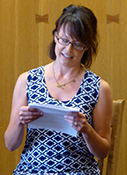- Campuses :
- Twin Cities
- Crookston
- Duluth
- Morris
- Rochester
- Other Locations

center for writing
mwp.umn.edu
Kate Mabel
©2014
 “It’s….”
“It’s….”
“Go kite!”
A group of 20 five- and six-year-olds read in unison. These words, the last two in their shared reading books, are actually just the printed word “go” and a picture of a kite with an exclamation mark. The eager young learners sit in a circle around a well-used acrylic carpet, two to three students per book.
Pairs of proud eyes look up from the books for feedback from their equally proud teacher.
“What is a kite?” the teacher asks. “Who can tell me what a kite is?”
Many colorful small hands appear in the air and a tiny called-upon voice confidently answers the question.
The teacher then asks another, more difficult question.
“What makes a kite fly?”
What makes a kite fly? As a teacher in training, I subtract twenty years and ponder with them. It’s a logical question to ask after reading a story about two friends, Nan and Pat, who work all day to get their kite in the air only to find success with an electric fan.
One boy’s hand shoots up. It’s the kind of “shoot” that makes those near him react. Like a champion game show contestant, he appears to have a natural question and answer reflex. Several of his fellow contestants instinctively raise their hands too; as they soon recall raising their hands means having an answer, their hands slowly lower.
The boy’s lips, tightly sealed, cause his cheeks to inflate to the point of popping. His eyes grow large, his eyebrows elevate to his hairline. He’s holding his breath, trying hard not to let the air inside him burst out in the form of an answer.
He knows the rules. He knows he must wait to be called on before he may speak.
He sits with his arm extended so high it stretches and lifts half his body off the floor. To stretch even higher, he pushes down with his unraised hand. The hem of his neatly tucked shirt pulls out of his belt-buckled pants. He takes a short breath on top of his already held breath.
He knows the rules.
His teacher calls on him, his lips unseal to release the pressure that’s been building inside of him, he boldly stands up and takes a dramatic, deep breath to say, “It’s…”
He knows the answer: el viento.
“It’s….”
All of his classmates remain seated, anticipating something mind-blowing.
![]() “It’s…
“It’s…
He confidently oscillates his head, creating air currents with all the capacity of his kindergarten lungs.
“Yes!” says his teacher, “It’s wind!” Everyone joins the boy in standing and blowing to celebrate this discovery of wind. If only Nan and Pat started their day in this classroom.
Out of breath but full of wonder, the students transition to their next activities.
I take this opportunity to learn more about the eager wind maker.
“What’s your name?” I ask him.
“Ah-lakes-ees,” he says with a lilting accent.
“Alexis, my name is Kate.” Some kids giggle when I say my name because it sounds like “cake” and they repeat, “Cake.” But Alexis sees my nametag and studies the letters as I introduce myself. He looks up at me, smiles, and says, “Kate.”
I smile an acknowledging smile back.
“Muy bien, Alexis.”
It didn’t take long to realize that Alexis captured every moment of learning and made it his own. He loved to listen, read, write, count, draw, and sing. When he expressed himself out loud, his voice rang an octave above the rest of his classmates. His remarkable zest for life brought joy to those around him. Alexis and his wind lifted me off the ground.
Alexis was one of 20 vibrant students in a kindergarten class in Minneapolis, Minnesota. Of the 20 students, Alexis and 15 of his classmates were English Language Learners.



